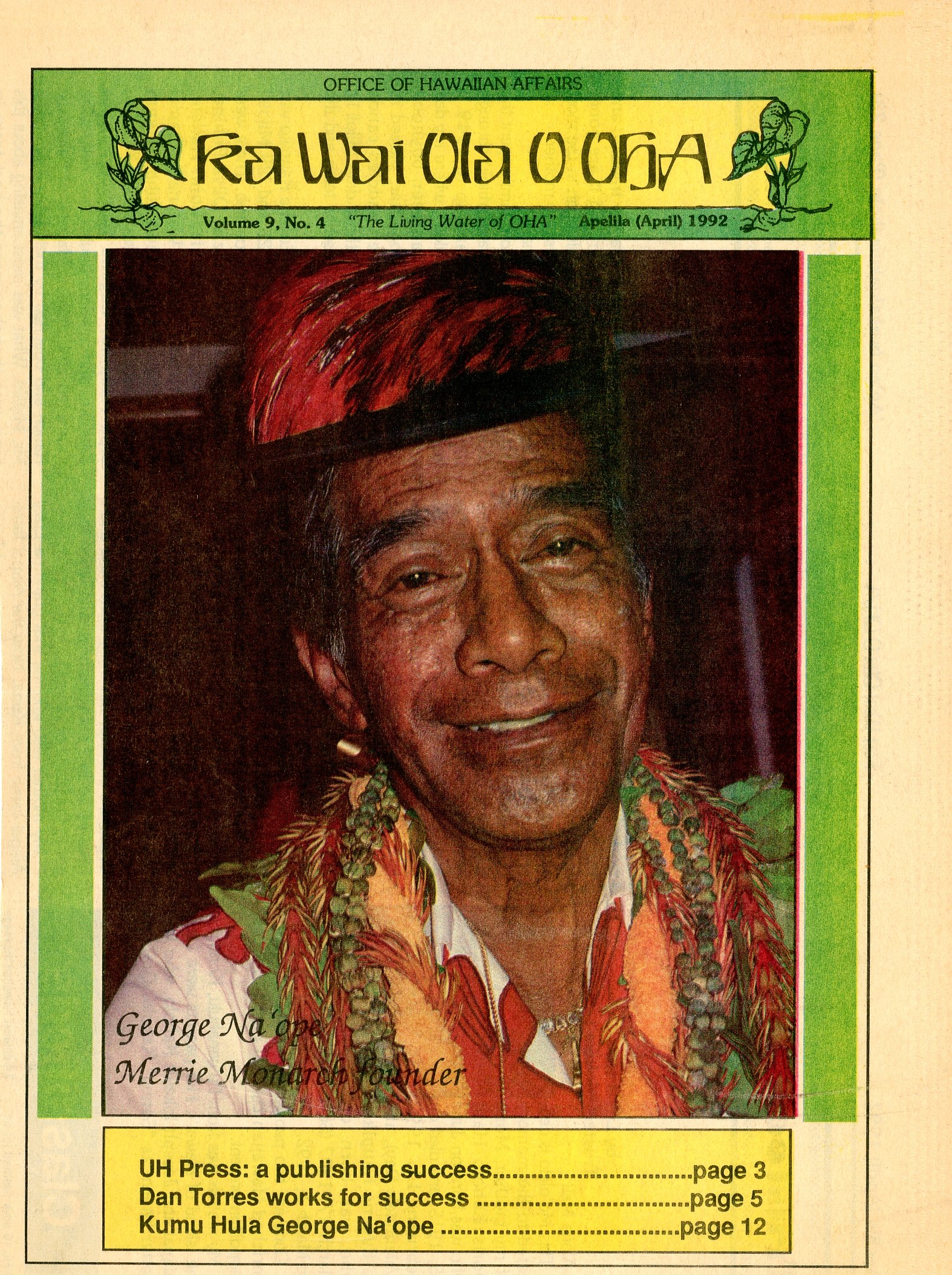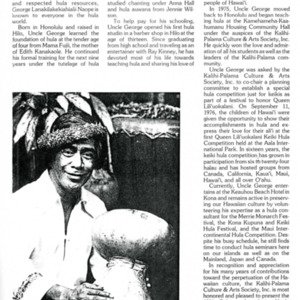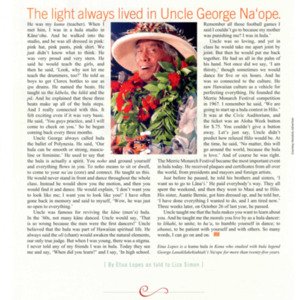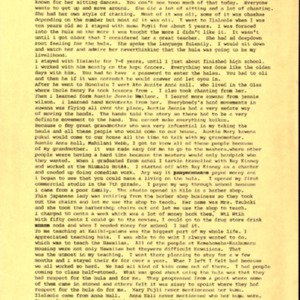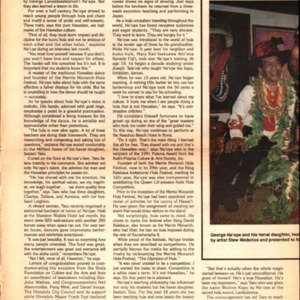George Lanakilakekiahiali'i Na'ope
Title
George Lanakilakekiahiali'i Na'ope
Subject
George Lanakilakekiahiali'i Na'ope text from Nānā I Na Loea Hula Vol One Page 112
Description
George Lanakilakekiahiali'i Na'ope
In 1973 George Na'ope co-founded the Merrie Monarch Hula Festival that is held annually in Hilo. Born in Kalihi, 0‘ahu, Mr. Na‘ope was raised in Hilo, Hawaii.
In the old days, everyone was afraid of knowledge being stolen so the old masters would die without sharing it. The different races that live here are part of the future of the culture. I teach Haole, Japanese, Pake, and I used to get scoldings because of it. I want to share because if we don’t share these dances they are going to die. My students are all different races but when they dance I know they’re Hawaiian.
My first kumu was a woman who lived next door to my family in Hilo. She was Edith Kanaka‘ole’s mother. Her name was Mama Fujii. She was married to a Japanese man. She was a short lady, even shorter than me but she was a master of the hula. I studied under Mama Fujii for five years and I will always remember her. I started with Mama Fujii when I was four-years-old. I’ll always consider her my kumu because she did the hard work. She was the one that gave me my foundation and my basics. The teacher that laid the foundation should be the teacher you give the greatest credit to. That’s the hardest thing to teach. Mama Fujii, first of all, was very strict. She and my great-grandmother were dear friends and that’s the reason I went to hula. My greatgrandmother told me that our kupunas were kumu pa‘as so she felt someone else in the family had better learn the hula. So it really wasn’t a matter of me having a choice about learning or not learning.
I was forced into the hula so the more I was taught the more I didn’t like it. It wasn’t until later that I realized how great a teacher Mama Fujii was. She spoke the language fluently and she had a deep-down, root feeling for the hula. Mama Fujii taught me only kahiko but since she was a Christian she only talked about the kapus during my training. She would also teach us sitting dances and the oli but there would be no kuahu. There would only be Christian prayers before and after we danced.
At the age of ten, I went on to Joseph ‘Ilala‘ole who I stayed with for ten years until he left for Honolulu to become a policeman. He taught me the kapu dances and unlike Mama Fujii the training was like the olden days. You had to chant a password to enter the halau and if it was correct, he would answer your chant and let you in.
After graduating from high school, I studied under Aunty Anna Hall who taught me chanting and Aunty Jennie Wilson who taught me ‘auwana. Aunty Jennie had a very sedate way of moving her hands. She taught me that the hands tell the story so nothing can be kuikau. Every hand movement had to be a definite motion.
My family was poor so I began to teach when I was thirteen- years-old. This Japanese lady named Mrs. Tsubaki was retiring from the barbershop business in Hilo so she took out all the chairs and let me use her shop to teach. I charged fifty cents a week and with that money I was able to get through school.
I think we need a separate festival of contemporary kahiko because I think within its own limits it’s great. Then we can have the great young kumu of this time create the chants and dances that reflect their era. I’ve seen tremendous changes in Hawai‘i since the Forties but of my generation there is not one chant that talks about the coming of the airplane, the war, or statehood.
I have tried to teach the hula as a classical traditional dance but others are teaching it as a modern, creative dance and are still calling it a traditional dance. Today we are seeing modern-day versions of what people think went on in ancient Hawai‘i. You have kids coming out who are confused and are calling personally-created motions, kahiko motions.
In 1973 George Na'ope co-founded the Merrie Monarch Hula Festival that is held annually in Hilo. Born in Kalihi, 0‘ahu, Mr. Na‘ope was raised in Hilo, Hawaii.
In the old days, everyone was afraid of knowledge being stolen so the old masters would die without sharing it. The different races that live here are part of the future of the culture. I teach Haole, Japanese, Pake, and I used to get scoldings because of it. I want to share because if we don’t share these dances they are going to die. My students are all different races but when they dance I know they’re Hawaiian.
My first kumu was a woman who lived next door to my family in Hilo. She was Edith Kanaka‘ole’s mother. Her name was Mama Fujii. She was married to a Japanese man. She was a short lady, even shorter than me but she was a master of the hula. I studied under Mama Fujii for five years and I will always remember her. I started with Mama Fujii when I was four-years-old. I’ll always consider her my kumu because she did the hard work. She was the one that gave me my foundation and my basics. The teacher that laid the foundation should be the teacher you give the greatest credit to. That’s the hardest thing to teach. Mama Fujii, first of all, was very strict. She and my great-grandmother were dear friends and that’s the reason I went to hula. My greatgrandmother told me that our kupunas were kumu pa‘as so she felt someone else in the family had better learn the hula. So it really wasn’t a matter of me having a choice about learning or not learning.
I was forced into the hula so the more I was taught the more I didn’t like it. It wasn’t until later that I realized how great a teacher Mama Fujii was. She spoke the language fluently and she had a deep-down, root feeling for the hula. Mama Fujii taught me only kahiko but since she was a Christian she only talked about the kapus during my training. She would also teach us sitting dances and the oli but there would be no kuahu. There would only be Christian prayers before and after we danced.
At the age of ten, I went on to Joseph ‘Ilala‘ole who I stayed with for ten years until he left for Honolulu to become a policeman. He taught me the kapu dances and unlike Mama Fujii the training was like the olden days. You had to chant a password to enter the halau and if it was correct, he would answer your chant and let you in.
After graduating from high school, I studied under Aunty Anna Hall who taught me chanting and Aunty Jennie Wilson who taught me ‘auwana. Aunty Jennie had a very sedate way of moving her hands. She taught me that the hands tell the story so nothing can be kuikau. Every hand movement had to be a definite motion.
My family was poor so I began to teach when I was thirteen- years-old. This Japanese lady named Mrs. Tsubaki was retiring from the barbershop business in Hilo so she took out all the chairs and let me use her shop to teach. I charged fifty cents a week and with that money I was able to get through school.
I think we need a separate festival of contemporary kahiko because I think within its own limits it’s great. Then we can have the great young kumu of this time create the chants and dances that reflect their era. I’ve seen tremendous changes in Hawai‘i since the Forties but of my generation there is not one chant that talks about the coming of the airplane, the war, or statehood.
I have tried to teach the hula as a classical traditional dance but others are teaching it as a modern, creative dance and are still calling it a traditional dance. Today we are seeing modern-day versions of what people think went on in ancient Hawai‘i. You have kids coming out who are confused and are calling personally-created motions, kahiko motions.
Citation
“George Lanakilakekiahiali'i Na'ope,” Nā Kumu Hula Archive, accessed December 13, 2025, https://nakumuhula.org/archive/items/show/22.





